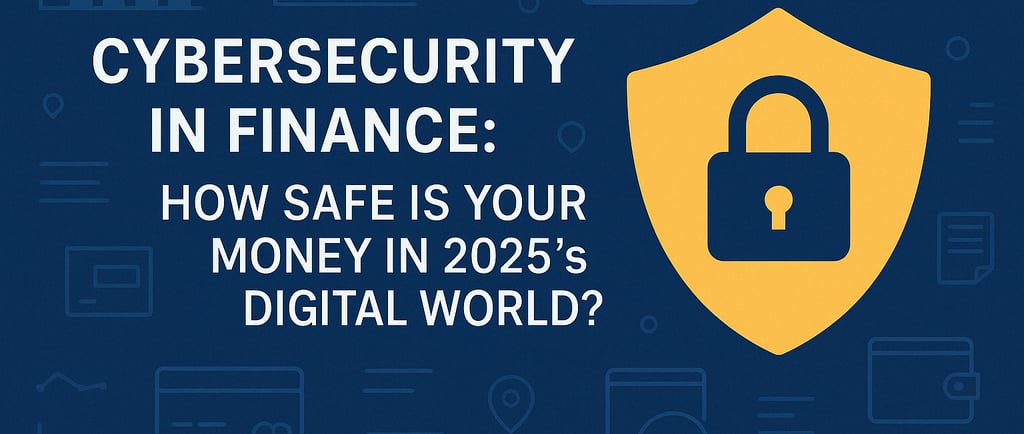Cybersecurity in Finance: How Safe Is Your Money in 2025’s Digital World?
4/15/20254 min read


Cybersecurity in Finance: How Safe Is Your Money in 2025’s Digital World?
In 2025, as India surges forward in its digital finance revolution, cybersecurity has emerged as both a necessity and a challenge. From Unified Payments Interface (UPI) and internet banking to digital wallets and robo-advisory platforms, Indians are embracing financial technology like never before. However, with innovation comes risk—and the security of your money in the digital world has never been more important.
This blog explores the current state of cybersecurity in finance, the evolving threats, major attacks, government measures, and how you can keep your money safe in a rapidly digitizing economy.
The Rise of Digital Finance—and Digital Risks
India’s financial ecosystem is one of the fastest digitizing in the world. UPI transactions crossed ₹18 lakh crore in monthly volume in early 2025. Meanwhile, millions of new users joined platforms offering online insurance, mutual fund investing, and instant credit through digital onboarding
While this convenience is revolutionary, it also introduces vulnerabilities. Every payment, login, and transaction becomes a potential entry point for fraudsters. As cybercriminals become more sophisticated, the financial risks for everyday consumers and businesses continue to rise.
Common Cybersecurity Threats in 2025
The threat landscape in 2025 is both diverse and constantly evolving. Some of the most prevalent cybersecurity risks in finance today include:
Phishing Attacks: Fraudsters continue to lure users into sharing sensitive information through fake emails, SMS messages, and clone websites.
Mobile App Cloning: Unauthorized copies of official banking or UPI apps are circulated to trick users into entering their credentials.
SIM Swapping: Criminals gain access to your mobile number by impersonating you to the telecom provider, intercepting OTPs and messages.
Credential Stuffing: Hackers use leaked username-password combinations to attempt logins across multiple platforms.
Ransomware: Though more common in institutions, individuals can also fall victim to malicious software that locks devices until a ransom is paid.
Clearly, the digital age demands more than just awareness—it requires proactive action.
Major Incidents That Raised Alarms
In recent years, India has witnessed several high-profile data breaches and financial cybercrimes. From fintech startups facing server breaches to phishing scams targeting elderly users of UPI, the impact is significant.
One notable incident occurred in 2024 when a massive phishing campaign compromised over 2.5 lakh digital wallet users by mimicking SMS alerts from payment platforms. In another case, a regional co-operative bank suffered a ransomware attack, causing operational disruption for over a week.
These attacks underline the importance of institutional security as well as personal vigilance.
How Banks and Fintechs Are Responding
Fortunately, financial institutions are not standing still. In 2025, most banks and registered fintech companies have significantly upgraded their cybersecurity frameworks.
Here are some key security protocols now in place:
Multi-Factor Authentication (MFA): Users must verify identity through two or more steps, including biometrics, OTPs, and device verification.
AI-Powered Fraud Detection: Machine learning models monitor user behavior and flag suspicious activity in real time.
Data Encryption Standards: End-to-end encryption is now a basic expectation in financial transactions.
Continuous Monitoring Systems: Cybersecurity teams work round the clock to identify and neutralize threats as they appear.
These innovations are part of a broader effort to maintain trust in digital finance while minimizing risk.
Role of the Government and RBI
Cybersecurity in finance is now a matter of national interest. The Reserve Bank of India (RBI) has issued several circulars mandating cybersecurity audits, digital payment safety standards, and customer protection norms.
Initiatives such as the Digital Payment Security Controls Directions (revised in 2023 and updated in 2025) aim to enhance the resilience of payment systems. Additionally, the government’s CERT-In (Computer Emergency Response Team) regularly monitors, publishes, and responds to cyber threats in financial infrastructure.
For consumers, regulatory support ensures that unauthorized digital transactions reported promptly are reimbursed within specific timelines.
How You Can Protect Your Money
While institutions and regulators are doing their part, individual users must also take cybersecurity seriously. Here are practical ways you can protect your financial data and funds in 2025:
Use Only Official Apps and Websites: Avoid third-party app stores or links received via SMS or social media.
Enable Two-Factor Authentication: For all banking, investment, and trading accounts, always activate 2FA.
Keep Software Updated: Regularly update your smartphone, antivirus, and banking apps to the latest versions.
Avoid Public Wi-Fi for Financial Transactions: Public networks are highly vulnerable to man-in-the-middle attacks.
Beware of Phishing Attempts: Never share OTPs, passwords, or banking credentials with anyone—even if they claim to be from your bank.
Use Strong, Unique Passwords: Avoid reusing the same password across platforms.
Ultimately, cybersecurity begins with personal responsibility.
The Future of Cybersecurity in Indian Finance
In the coming years, cybersecurity will be at the heart of financial innovation. Banks are already investing in zero-trust architecture, blockchain-backed transaction ledgers, and AI-powered biometric systems.
As India explores its own Digital Rupee (CBDC), robust cybersecurity protocols will be critical to ensure nationwide adoption. Likewise, the integration of smart contracts, open banking APIs, and embedded finance models will demand even stricter data controls and user awareness.
Financial literacy will no longer be limited to understanding interest rates and savings schemes—it must include digital hygiene and online safety.
Conclusion
In 2025, the question is no longer whether digital finance is the future—it already is. The real question is: how safe is your money in this fast-evolving financial landscape?
The answer lies in shared responsibility. Regulators must enforce strict compliance, institutions must build secure platforms, and users must adopt secure habits. Only then can India unlock the full potential of its digital economy without compromising trust or security.
As digital finance continues to grow, cybersecurity will remain its most crucial pillar. Now more than ever, staying informed and alert is your best defense.
About One Solution
Quick Links
Contact Info
One Solution — Your trusted partner for financial success.
📍 F17, Grand Plaza, Paltan Bazar
Guwahati, Kamrup (M), Assam
India, Pin: 781008
📞 9650072280
© 2025 One Solution. All Rights Reserved.
